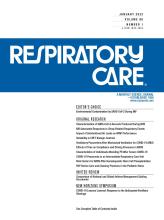This article requires a subscription to view the full text. If you have a subscription you may use the login form below to view the article. Access to this article can also be purchased.
Abstract
BACKGROUND: Patients requiring mechanical ventilation due to COVID-19 have different characteristics of evolution and outcome compared to the general ICU population. Although early weaning from mechanical ventilation is associated with improved outcomes, inadequate identification of patients unable to be weaned may lead to extubation failure and increased days on mechanical ventilation. Outcomes related to mechanical ventilation weaning in this population are scare and inconclusive. Therefore, the objective of this study was to describe the characteristics of mechanical ventilation weaning in subjects with acute respiratory failure induced by COVID-19.
METHODS: This was a multi-center, prospective cohort study. We included adult subjects requiring at least 12 h of mechanical ventilation due to COVID-19 infection admitted to any participating ICUs. Characteristics of the mechanical ventilation weaning and extubation process, as well as clinical results, were the primary outcome variables. Weaning types were defined according to previously described and internationally recognized categories.
RESULTS: Three hundred twenty-six subjects from 8 ICUs were included. A spontaneous breathing trial (SBT) was not performed in 52.1% of subjects. One hundred twenty-eight subjects were extubated, and 29.7% required re-intubation. All the subjects included could be classified by Weaning according to a New Definition (WIND) classification (group 0 = 52.1%, group 1 = 28.5%, group 2 = 8.0%, and group 3 = 11.3%) with statistically significant differences in duration of mechanical ventilation (P < .001) and ICU length of stay (P < .001) between groups.
CONCLUSIONS: The mechanical ventilation weaning process in subjects with COVID-19 was negatively affected by the disease, with many subjects never completing an SBT. Even though temporal variables were modified, the clinical outcomes in each weaning group were similar to those previously reported.
- mechanical ventilation
- ICU
- epidemiology
- weaning mechanical ventilation
- respiratory distress syndrome
- COVID-19
Footnotes
- Correspondence: Javier H Dorado PT, Elpidio Gonzalez 5350, ZIP1407 Buenos Aires, Argentina. E-mail: javierhdorado{at}gmail.com
EpVAr Study Group: Norberto Tiribelli (Complejo Médico PFA Churruca Visca, CABA, Argentina), Roberto Gonzalez (Hospital Interzonal de Agudos Evita, Avellaneda, PBA, Argentina), Romina Pratto (Sanatorio Anchorena Recoleta, CABA, Argentina), Patricio Gaggino (Sanatorio de Los Arcos, CABA, Argentina), Gimena Cardoso (Sanatorio Anchorena de San Martín, PBA, Argentina), Judith Sagardía (Hospital Nacional Dr. Alejandro Posadas, PBA, Argentina), Emilio Steinberg (Sanatorio Colegiales, CABA, Argentina), and Nahuel Dargains (HIEA y C San Juan de Dios, Buenos Aires, Argentina).
The authors have disclosed no conflicts of interest.
Mr Dorado presented a version of this paper at the 31st Argentinian and International Conference of Critical Care, held virtually November 16–19, 2021.
Mr Plotnikow presented a version of this paper at the 17th Uruguayan and International Conference of Critical Care, held virtually December 7–10, 2021.
Supplementary material related to this paper is available at http://www.rcjournal.com.
- Copyright © 2023 by Daedalus Enterprises
Pay Per Article - You may access this article (from the computer you are currently using) for 1 day for US$30.00
Regain Access - You can regain access to a recent Pay per Article purchase if your access period has not yet expired.











